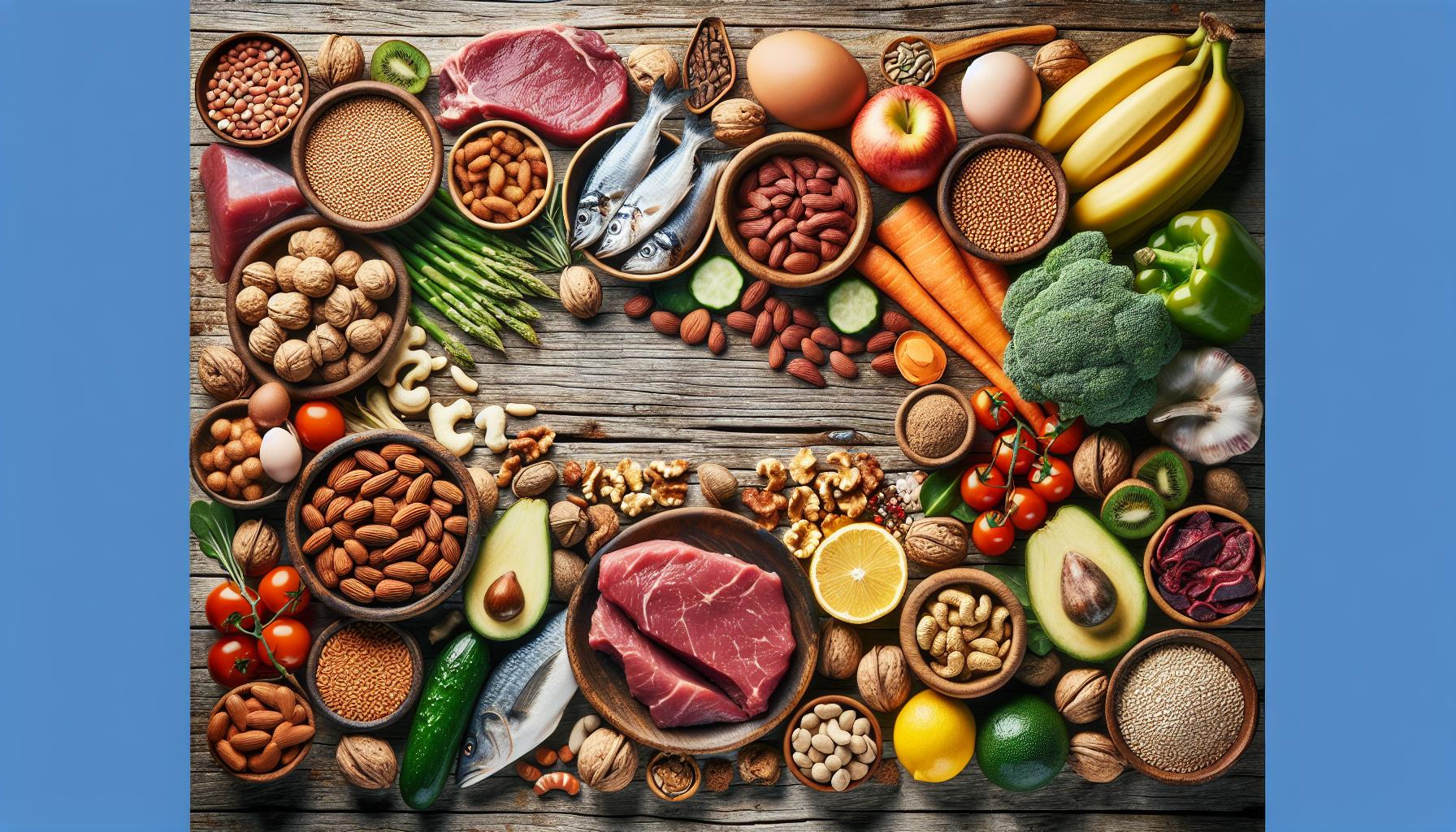Ever wondered about the secrets of our ancient ancestors’ diet? Welcome to the world of the Paleo diet, a nutritional plan based on foods available during the Paleolithic era. This diet, also known as the Stone Age diet, champions lean meats, fish, fruits, vegetables, nuts, and seeds, while shunning dairy, grains, legumes, and processed foods.
The Paleo diet promises several potential benefits, from weight loss to improved blood sugar control. Yet, it’s not without its critics, with some pointing out potential drawbacks such as restrictive food groups and possible nutrient deficiencies. So, is it the right diet for you? Let’s investigate into the pros and cons of the Paleo diet to help you make an well-informed choice.
Understanding the Paleo Diet
The Core Principles of the Paleo Diet
The Paleo diet takes inspiration from the eating habits of our ancestors from the Paleolithic era. It revolves around the idea of consuming whole and unprocessed foods, akin to the food consumed by hunter-gatherers. These pre-agricultural humans relied primarily on fruits, vegetables, lean meats, fish, nuts, and seeds for nourishment. The proponents of the Paleo diet argue that such foods align closely with our biological needs, thereby promoting optimal health.
This diet certainly reinforces healthy eating habits by promoting nutrient-dense foods while discouraging high-calorie processed ones. Some research indicates that this diet can lead to significant weight loss, improved glucose tolerance, and insulin sensitivity. It also reduces heart disease risk factors and can be an excellent choice for those sensitive to grains, dairy, and legumes.
Foods Allowed on the Paleo Diet
Now that you’ve grasped the principles of the Paleo diet, let’s investigate into what you can eat. The focus is on unprocessed foods to simulate, as close as modern life allows, the diet of our stone-age ancestors. So, your plates get loaded with whole foods like:
- Proteins: Lean meats and fish offer significant protein.
- Fruits and Vegetables: They offer essential vitamins, minerals, and fibre for a balanced diet.
- Nuts and Seeds: These provide healthy fats and fibre.
- Healthy fats and oils: They can include, for instance, avocado oil and coconut oil.
A key concept in the Paleo diet is choosing quality over quantity, reinforcing mindful eating.
Foods Restricted on the Paleo Diet
While the Paleo diet does remove multiple food groups from your plate, remember it’s all in aid of a healthier you. Foods to avoid while following a Paleo plan include:
- Dairy: The aim is to steer clear from all processed foods, which includes all forms of dairy excluding certain hard cheeses and butter.
- Legumes: These include foods like lentils, beans, peanuts, and peas.
- Grains: Wheat, oats, barley, and other grain products are out of bounds.
- Processed foods and sugars: This diet eliminates sugar, soft drinks, artificial sweeteners, and all packaged and processed foods.
While the banning of these food groups may seem highly restrictive, it’s crucial to look at the nutritional silver lining. The Paleo diet could be an effective tool for individuals looking to lose weight or improve their overall health. Nonetheless, adopting a new diet should be a personalised decision, keeping one’s health condition, body requirements and personal liking in mind.
Nutrition Profile of the Paleo Diet

Unpacking the diet’s nutritional highlights, you’ll find that the cornerstone of the Paleo diet lies in its nutrient-rich whole foods. The diet shuns high-fat and processed foods, low in nutritional profile and packed with calories. Instead, it throws the spotlight on fresh fruits and vegetables brimming with essential vitamins, minerals, and fibre. These heroes of the diet bring not only a bevvy of nutrients to the table but also serve to increase satiety, making a significant impact on weight management.
Protein sources, predominantly meats, play a pivotal role in the Paleo diet. Their magic lies in their ability to suppress ghrelin, commonly dubbed the hunger hormone . This control mechanism keeps hunger pangs at bay for longer, smoothing your road to weight loss.
The Paleo diet signature lies in its low-carb and low glycaemic index food choices. These gems of the diet work diligently to prevent excessive inflammation in the body. Why does that matter, you ask? Well, inflammation heightens the risk of stumbling into several health pitfalls – among them type 2 diabetes, cancer, cardiovascular disease, and pulmonary disease.
It’s also worth noting constraints – your saturated fat intake might skyrocket on the Paleo diet. It’s recommended to cap this to no more than 13 grams per day, keeping cholesterol and heart disease risks on a tight leash. Hence, while there’s a lot of meat on the Paleo menu, it’s paramount that you keep portions in check.
The Pros and Cons of the Paleo Diet

Stating the Pros
Diving into the pros of the Paleo diet, the initial benefit that strikes the mind is potential weight loss. Studies indicate that this diet leads to significant reduction in body fat and waist circumference. This stands attributed to the diet’s emphasis on wholesome and satiating foods, pushing aside high-calorie processed foods.
Secondly, the Paleo diet has been proven to enhance blood sugar control, showing improvements in glucose tolerance and insulin sensitivity. This arises from the avoidance of refined carbohydrates, replacing them with protein and fibre-rich options to stabilise blood sugar levels.
Continuing on, this diet also contributes to a decrease in heart disease risk by providing improvements in blood pressure, triglyceride levels, and good cholesterol (HDL). This can be traced back to the high intake of anti-inflammatory omega-3 fats, antioxidants, and fibre through the Paleo diet.
Finally, the Paleo diet is rich in nutrients, given the emphasis on fruits, vegetables, and unprocessed animal foods. The intake of essential nutrients like potassium, magnesium, vitamins A, C, E and folate is higher compared to typical Western diets.
Discussing the Cons
Even though the plethora of benefits, the Paleo diet isn’t without its potential drawbacks. First, it is a highly restrictive diet, warranting complete exclusion of entire food groups such as grains and dairy. This limitation might, in turn, reduce diet diversity and make it challenging if you’re looking to embrace the Paleo approach in the long-term.
Nutrient deficiencies form the second concern associated with this diet. The elimination of nutrient-rich foods like whole grains and legumes can lead to lower nutrient intake and potential deficiencies in the long run.
Finally, the Paleo diet can also increase the risk of certain health issues. Lower intake of resistant starch, altered gut microbiota composition, and increased serum cholesterol concentrations are few potential risks tied with this diet.
Even though the potential cons, the Paleo diet’s focus on whole, nutrient-dense foods provides undeniable benefits. But, each person’s dietary needs and tolerances are different. Hence, while the Paleo diet might be suitable for some, it may not be the ideal solution for everyone. Always consult with a healthcare professional or a registered dietitian before starting any new diet plan.
Case Studies: Successes and Challenges

Diving into practical examples provides more clarity on the Paleo diet’s application in real-life scenarios. As each individual’s dietary efficacy varies greatly, it’s essential to review how this diet has been implemented by specific cohorts or populations. We’ll explore both successful cases and those that bump up against challenges, offering a well-rounded depiction of real-world diet experiences.
Notably, Paleo-focused eating habits have made strides in the world of chronic disease treatment. For instance, multiple individuals have reported experiencing substantial improvements in chronic conditions by adopting this nutritional plan. That indeed counts as a significant success directly linked to Paleo-style food choices.
But, any potential success with this diet isn’t without its hurdles. Some people, especially those accustomed to Western diets, may find it quite challenging to stick to the Paleo diet’s stringent guidelines. Diverting from accustomed convenience food towards the Paleo diet requires a certain level of discipline, impacting compliance rates.
Another reported challenge is melding paleo guidelines with other dietary practices, such as time-restricted feeding or intermittent fasting. Although studies reveal some promising results about weight reduction, the lack of long-term data brings a level of uncertainty to this combined practice.
In sum, anecdotal evidence and case studies reflect a mixed bag of results. Successes seem to tilt towards those battling chronic disease while some challenges persist, especially when integrating with other dietary trends. Remember: success is contingent on individual circumstances and commitment levels, highlighting the importance of personalised dietary guidance.
Paleo Diet – Comparison with Other Diets

Although the Paleo diet possesses several benefits such as potent weight loss, improved blood sugar control, reduced heart disease risk factors, increased nutrient density, and elimination of problematic foods, it’s equally important to understand its comparative effectiveness against other diets.
One study found Paleo more satiating per calorie than the Mediterranean diet. This result directly affects weight management, as feeling satisfied after meals minimises snack cravings and unnecessary caloric intake. Besides, Paleo improves several crucial parameters like blood pressure, glucose tolerance, and blood lipids, enhancing overall health factors.
Yet, matching macronutrients and calories plays a pivotal role in this equation. Protein intake differentiates significantly in comparing diets, with Paleo often providing more protein than other diet regimens. Hence, it’s more like comparing grains to goat meat, rather than apples to oranges, highlighting the importance of context in comparisons.
Nevertheless, the Paleo diet also presents limitations. It’s typically high in saturated fats, which, if exceeded a cap of 13 grams per day, could lead to high cholesterol and heart diseases. Red meat, a common inclusion in Paleo, poses risks, potentially causing kidney damage if one exceeds 12-18 ounces (approximately 350-500 grams) per week. Hence, exploring these aspects requires keen attention and awareness.
Eventually, comparing Paleo with other diets aids in outlining its relative strengths and potential caveats. Yet, remember, the right diet ideally tailors to your exclusive health needs and lifestyle preferences.
Expert Opinions on the Paleo Diet

Explore as experts weigh in on the Paleo diet. They’ve pored over countless clinical studies, like those of Ryberg M et al. and Jönsson T et al., which extol the robust effects of this prehistoric diet on obesity and diabetes. Other researchers, such as Siri-Tarino PW and Hoenselaar R, challenge the diet’s high saturated fat content, citing its inconsistent association with cardiovascular diseases.
A point to note is Paleo diet’s versatility in meal timings. Some proponents like Loren Cordain recommend synchronising eating patterns with the body’s circadian rhythm, while others propose incorporating intermittent fasting.
When adopting the Paleo diet, consider these tips. First, heed its lack of portion references that might lead to overconsumption of certain foods. Second, remain aware of its inherent limitations. Elimination of food groups like grains or dairy might risk nutrient deficiencies, hence, complement the diet with nutrient-rich natural foods.
Finally, always tailor diets to your needs. After all, a diet should be paradisiacal, nourishing you while keeping your palate piqued.
Nutritional Recommendations for Paleo Diet Enthusiasts
Embarking on the Paleo diet demands quite a shift in dietary habits, necessitating thoughtful meal planning to meet nutritional requirements. High in saturated fats, limited intake of no more than 13 grams per day is suggested, according to the American Heart Association (AHA). An oversupply of red meat, typically linked with the Paleo diet, poses a risk of kidney damage. Hence, a ceiling of 350-500 grams, roughly 12-18 ounces per week, is advocated.
Protein is a staple in this diet, fuelling muscle growth and stability, yet an excess could conversely mean insufficient carbohydrate intake, your principal source of energy for physical activities. If you are athletically inclined, or simply lead a physically demanding lifestyle, the restrictive carbohydrate allowance may not serve you well.
Given that the Paleo diet is devoid of specified portion sizes, caution must be exercised. You might find yourself unwittingly consuming an excess of certain approved foods, tilting the scales on your caloric intake.
As with all diet plans, individual health conditions and needs remain paramount. It’s particularly crucial that individuals with existing heart conditions tread lightly, with reduced red meat consumption advised.
Conclusion
So, you’ve seen that the Paleo diet has its pros and cons. It’s a lifestyle change that can lead to weight loss and better health markers. But, it’s not without its critics who point out potential nutrient deficiencies and high saturated fat content. It’s clear that success on the Paleo diet requires careful meal planning and moderation, particularly with red meat and saturated fats. Remember, portion control is key and it’s essential to tailor the diet to your individual health needs and personal preferences. If you have existing heart conditions, it’s particularly important to watch your red meat intake. Above all, a diet should provide nourishment and enjoyment, so find what works best for you.

